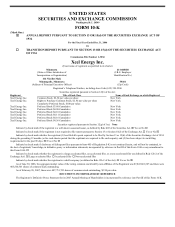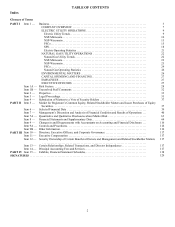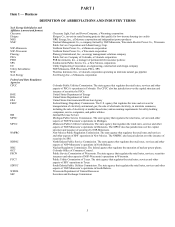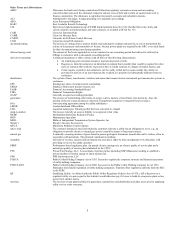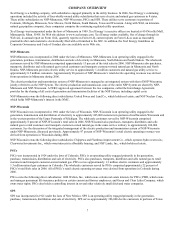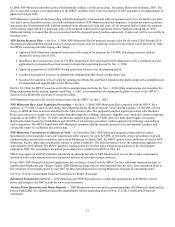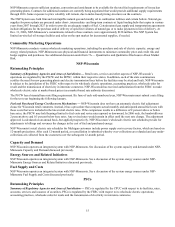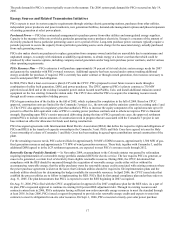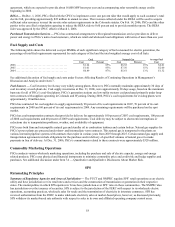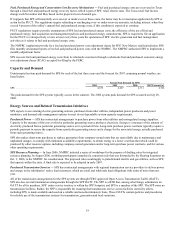Xcel Energy 2006 Annual Report Download - page 21
Download and view the complete annual report
Please find page 21 of the 2006 Xcel Energy annual report below. You can navigate through the pages in the report by either clicking on the pages listed below, or by using the keyword search tool below to find specific information within the annual report.
11
NSP-Minnesota is required by Minnesota law to spend a minimum of 2 percent of Minnesota electric revenue on conservation
improvement programs. These costs are recovered through an annual cost recovery mechanism for electric conservation and energy
management program expenditures. NSP-Minnesota is required to request a new cost recovery level annually.
MERP Rider Regulation — In December 2003, the MPUC approved NSP-Minnesota’s MERP proposal to convert two coal-fueled
electric generating plants to natural gas, and to install advanced pollution control equipment at a third coal-fired plant. These
improvements are expected to significantly reduce air emissions from these facilities, while increasing the capacity at system peak by
300 MW. The projects are expected to come on line between 2007 and 2009, at a cumulative investment of approximately $1 billion.
The MPUC approved a rate rider to recover prudent costs of the projects from Minnesota customers beginning Jan. 1, 2006, including
a rate of return on the construction work in progress. The MPUC approval has a sliding ROE scale based on actual construction cost
compared with a target level of construction costs (based on an equity ratio of 48.5 percent and debt of 51.5 percent) to incentivize
NSP-Minnesota to control construction costs. At Dec. 31, 2006, the estimated ROE was 10.74 percent, based on construction progress
to date.
Actual Costs as a Percent of Target Costs ROE
Less than or equal to 75%.................................................... 11.47%
Over 75% and up through 85% ................................................ 11.22%
Over 85% and up through 95% ................................................ 11.00%
Over 95% and up through 105% ............................................... 10.86%
Over 105% and up through 115% .............................................. 10.55%
Over 115% and up through 125% .............................................. 10.22%
Over 125%................................................................ 9.97%
Capacity and Demand
Uninterrupted system peak demand for the NSP System’s electric utility for each of the last three years and the forecast for 2007,
assuming normal weather, are listed below.
System Peak Demand (in MW)
2004 2005 2006 2007 Forecast
NSP System ........................ 8,665 9,212 9,787 9,623
The peak demand for the NSP System typically occurs in the summer. The 2006 system peak demand for the NSP System occurred on
July 31, 2006.
Energy Sources and Related Initiatives
NSP-Minnesota expects to use existing electric generating stations, purchases from other utilities, independent power producers and
power marketers, demand-side management options, new generation facilities and phased expansion of existing generation at select
power plants to meet its system capacity requirements.
Purchased Power — NSP-Minnesota has contractual arrangements to purchase power from other utilities and nonregulated energy
suppliers. Capacity is the measure of the rate at which a particular generating source produces electricity. Energy is a measure of the
amount of electricity produced from a particular generating source over a period of time. Long-term purchase power contracts
typically require a periodic payment to secure the capacity from a particular generating source and a charge for the associated energy
actually purchased from such generating source.
NSP-Minnesota also makes short-term purchases to replace generation from company-owned units that are unavailable due to
maintenance and unplanned outages, to comply with minimum availability requirements, to obtain energy at a lower cost than that
which could be produced by other resource options, including company-owned generation and/or long-term purchase power contracts,
and for various other operating requirements.
Excelsior Energy Inc. (Excelsior) — In December 2005, Excelsior, an independent energy developer, filed a power purchase
agreement with the MPUC seeking a declaration by the MPUC that NSP-Minnesota be compelled to enter into a power purchase
agreement and purchase the output from each of two integrated gas combined cycle (IGCC) plants to be located in northern
Minnesota. Excelsior filed this petition making claims pursuant to Minnesota statutes, relating to Innovative Energy Project and Clean
Energy Technology.
The MPUC referred this matter to a contested case hearing to develop the facts and issues that must be resolved to act on Excelsior’s
petition, including development of price information. The contested case proceeding considered a 603 MW unit in phase I and a
second 603 MW unit in phase II of Excelsior project.


